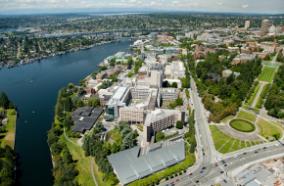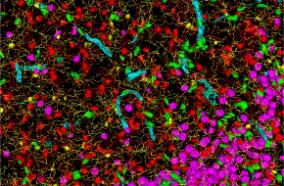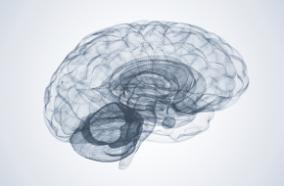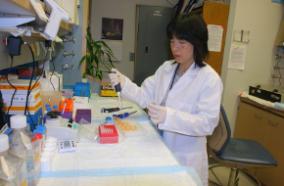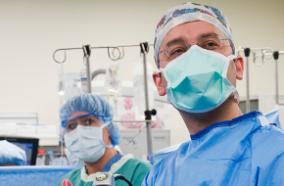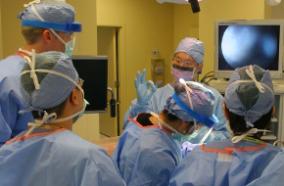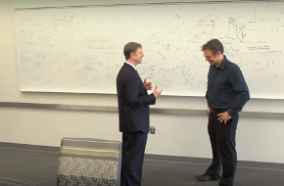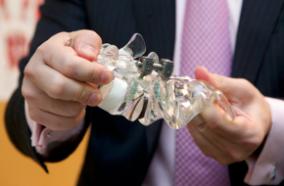4 years 7 months ago
Glioblastoma stem-like cells dynamically transition between a chemoradiation-resistant state and a chemoradiation-sensitive state. However, physical barriers in the tumour microenvironment restrict the delivery of chemotherapy to tumour compartments that are distant from blood vessels. Here, we show that a massively parallel computational model of the spatiotemporal dynamics of the perivascular niche that incorporates glioblastoma stem-like cells and differentiated tumour cells as well as...
Amanda Randles
4 years 7 months ago
Parkinson's disease (PD) is a chronic and progressive movement disorder with the urgent unmet need for efficient symptomatic therapies with fewer side effects. GPR6 is an orphan G-protein coupled receptor (GPCR) with highly restricted expression in dopamine receptor D2-type medium spiny neurons (MSNs) of the indirect pathway, a striatal brain circuit which shows aberrant hyperactivity in PD patients. Potent and selective GPR6 inverse agonists (IAG) were developed starting from a low-potency...
Huikai Sun
4 years 8 months ago
Deltamethrin (DLM) is a Type II pyrethroid pesticide widely used in agriculture, homes, public spaces, and medicine. Epidemiological studies report that increased pyrethroid exposure during development is associated with neurobehavioral disorders. This raises concern about the safety of these chemicals for children. Few animal studies have explored the long-term effects of developmental exposure to DLM on the brain. Here we review the CNS effects of pyrethroids, with emphasis on DLM. Current...
Emily M Pitzer
4 years 8 months ago
CONCLUSIONS: Laparoscopic MD resection has shorter LOS and similar complications and operative time compared to an open approach while LCO resection increases operative time but not LOS or morbidities.
Nicholas J Skertich
4 years 8 months ago
Methods for quantifying gene expression¹ and chromatin accessibility² in single cells are well established, but single-cell analysis of chromatin regions with specific histone modifications has been technically challenging. In this study, we adapted the CUT&Tag method³ to scalable nanowell and droplet-based single-cell platforms to profile chromatin landscapes in single cells (scCUT&Tag) from complex tissues and during the differentiation of human embryonic stem cells. We focused on profiling...
Steven J Wu
4 years 8 months ago
Pancreatic cancer is the fourth leading cause of cancer-related death among men and women in the United States. A major challenge in treatment remains patients' advanced disease at diagnosis. The NCCN Guidelines for Pancreatic Adenocarcinoma provides recommendations for the diagnosis, evaluation, treatment, and follow-up for patients with pancreatic cancer. Although survival rates remain relatively unchanged, newer modalities of treatment, including targeted therapies, provide hope for improving...
Margaret A Tempero
4 years 8 months ago
CONCLUSIONS: The paucity of donor hearts has led to the development of left-ventricular assist devices as a BTT or as a destination therapy (DT). Outcomes after cf-LVAD implantation are excellent, with short-term survival comparable to heart transplantation, but long-term survival remains limited due to the incidence of post-implantation adverse events. Despite these complications, quality of life and functional status improve significantly post-implantation and remain improved over the...
Nicholas McNamara
4 years 8 months ago
CONCLUSIONS: To assure data consistency and high quality of the tumor response assessment data, our new CTIMS can minimize human input error by using standard-compliant eCRF with an automatic verification module and automatically transform the datasets into CDISC SDTM format.
Amy Junghyun Lee
4 years 8 months ago
CONCLUSIONS: The 18S rRNA gene qPCR assay is specific and highly reproducible and can provide reliable and accurate parasite quantification. The assay is considered fit for use in evaluating drug efficacy in malaria clinical trials.
Claire Y T Wang
4 years 8 months ago
The specialist cadre of the Royal Army Dental Corps (RADC) came to fruition at the start of World War II, with the speciality of maxillofacial surgery being born during World War I. The cadre has followed developments within the speciality, and building on the experience of forebears, has become capable of not only providing a secondary care service to the RADC but also being competent in the management of complex war injuries.
Michael D Williams
4 years 8 months ago
The Glasgow Outcome Scale (GOS) in its original or extended (GOSE) form is the most widely used assessment of global disability in traumatic brain injury (TBI) research. Several publications have reported concerns about assessor scoring inconsistencies, but without documentation of contributing factors. We reviewed 6801 GOSE assessments collected longitudinally, across 18 sites in the 5-year, observational Transforming Research and Clinical Knowledge in TBI (TRACK-TBI) study. We recorded error...
Kim Boase
4 years 8 months ago
CONCLUSIONS: We recommend including measures representing units of service with specific recall periods (e.g., 6 months vs. lifetime), and collecting healthcare resource utilization data using single-question measures to reduce missingness.
Michelle A Papp
4 years 8 months ago
CONCLUSION: This finding deserves further investigation to determine if tozuleristide "Tumor Paint" may have a wider role in the identification of non-neoplastic intracranial pathologies.
Andrew J Kobets
4 years 8 months ago
Opioid-induced respiratory depression (OIRD) represents the primary cause of death associated with therapeutic and recreational opioid use. Within the United States, the rate of death from opioid abuse since the early 1990s has grown disproportionally, prompting the classification as a nationwide "epidemic." Since this time, we have begun to unravel many fundamental cellular and systems-level mechanisms associated with opioid-related death. However, factors such as individual vulnerability,...
Jan-Marino Ramirez
4 years 8 months ago
BACKGROUND: Variable density spiral (VDS) pulse sequences with motion compensated compressed sensing (MCCS) reconstruction allow for whole-heart quantitative assessment of myocardial perfusion but are not clinically validated.
Jonathan A Pan
4 years 8 months ago
CONCLUSIONS AND RELEVANCE: This study found that women were more vulnerable than men to persistent mTBI-related cognitive and somatic symptoms, whereas no sex difference in symptom burden was seen after orthopedic injury. Postconcussion symptoms were also worse in women aged 35 to 49 years than in younger and older women, but further investigation is needed to corroborate these findings and to identify the mechanisms involved. Results suggest that individualized clinical management of mTBI...
Harvey S Levin
4 years 8 months ago
Pulmonary artery intimal sarcoma (PAIS) is an extremely rare malignant tumour. It is often misdiagnosed as chronic pulmonary thromboembolism. We describe a complex case in a 70-year-old man with PAIS extending into his right ventricle undergoing salvage cytoreductive surgical resection utilizing bivalirudin for cardiopulmonary bypass anticoagulation due to heparin-induced thrombocytopenia and thrombosis syndrome. The prognosis for PAIS is extremely poor, with a median survival of 1.5 months...
Michael L Williams
4 years 8 months ago
No abstract
Dararat Mingbunjerdsuk
4 years 8 months ago
CONCLUSION: In a large, single-center report of 5-FU associated vasospasm, patients who developed vasospasm were younger, had lower rates of traditional cardiovascular risk factors and had no significant difference in progression-free or overall survival compared to those who did not develop vasospasm.
Amna Zafar
4 years 8 months ago
Histone deacetylase 2 (HDAC2) is a major HDAC protein in the adult brain and has been shown to regulate many neuronal genes. The aberrant expression of HDAC2 and subsequent dysregulation of neuronal gene expression is implicated in neurodegeneration and brain aging. Human induced pluripotent stem cell-derived neurons (hiPSC-Ns) are widely used models for studying neurodegenerative disease mechanisms, but the role of HDAC2 in hiPSC-N differentiation and maturation has not been explored. In this...
Harald Frankowski
"university of washington"[affiliation] and neurological surge...: Latest results from PubMed
More posts about UW Neurological Surgery Recent PubMed Publications


